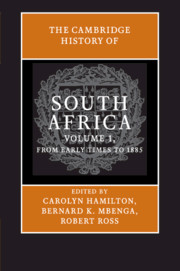Book contents
- Frontmatter
- 1 The Production of Preindustrial South African History
- 2 The Appearance of Food Production in Southern Africa 1,000 to 2,000 Years Ago
- 3 Farming Communities of the Second Millennium: Internal Frontiers, Identity, Continuity and Change
- 4 Khoesan and Immigrants: The Emergence of Colonial Society in the Cape, 1500–1800
- 5 Turbulent Times: Political Transformations in the North and East, 1760s–1830s
- 6 From Slave Economy to Settler Capitalism: The Cape Colony and Its Extensions, 1800–1854
- 7 From Colonial Hegemonies to Imperial Conquest, 1840–1880
- 8 Transformations in Consciousness
- Index
- References
8 - Transformations in Consciousness
Published online by Cambridge University Press: 28 September 2010
- Frontmatter
- 1 The Production of Preindustrial South African History
- 2 The Appearance of Food Production in Southern Africa 1,000 to 2,000 Years Ago
- 3 Farming Communities of the Second Millennium: Internal Frontiers, Identity, Continuity and Change
- 4 Khoesan and Immigrants: The Emergence of Colonial Society in the Cape, 1500–1800
- 5 Turbulent Times: Political Transformations in the North and East, 1760s–1830s
- 6 From Slave Economy to Settler Capitalism: The Cape Colony and Its Extensions, 1800–1854
- 7 From Colonial Hegemonies to Imperial Conquest, 1840–1880
- 8 Transformations in Consciousness
- Index
- References
Summary
This chapter considers changes in the way South Africans understood themselves, the world and their places in it, over almost the whole of the nineteenth century. As the rest of this volume shows, this was the formative century for South African society, entailing its bloodiest wars, its profoundest heterogeneity, the extension of colonial rule, and the reduction of most people to semiproletarian subjection. People’s sense of who they were and what they were about changed during this time, giving rise to identities and affiliations in forms that are still recognizable today.
That South Africans’ consciousness changed may be so, but what can usefully be said about the process is a more confounding question. For instance, although Marx and Freud both put great stock in the idea of “making conscious,” both also saw consciousness as an ephemera. Neither man thought a useful history could be written about ideology seen apart from the material apparatuses that give rise to it. Nietzsche depicted consciousness as a kind of side effect of life, with no agency; it was “the last and weakest of the senses.” There are also philosophers who view consciousness as an yet-undiscovered physicochemical system in the brain. In this chapter, habits are also of interest, what Pierre Bourdieu called praxis, the acting-through of ordinary life. Clearly, praxis is mostly not conscious. Wittgenstein pointed out that living always comes before rules: that, as he puts it, one learns to calculate by calculating. Social science rules are second-order principles, formed from descriptions of people who just “know their way around.”
- Type
- Chapter
- Information
- The Cambridge History of South Africa , pp. 392 - 448Publisher: Cambridge University PressPrint publication year: 2009



